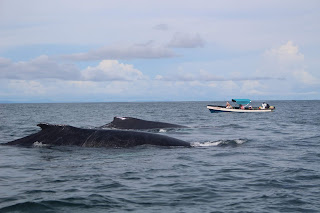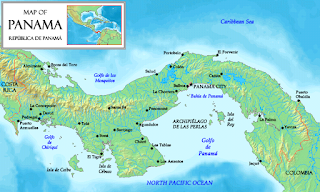The Wrap Up...
Contrary to what the title of the post may lead you to believe, this may not be the last post I will make to this blog. While this season in Panama has come to a close, it is likely that there will be future trips there, (or maybe elsewhere??) which may call on me to restart this blog.
On the second to last week of the trip, my ASU advisor and another of the project advisors/consultants (in charge of the social science/economic surveys), came down to Panama to visit the field site and to workshop the project plans. Together with my main project advisor, his intern, A.A and I all stayed out on the island of Contadora for a week (6 total). We spent the days going out to search for whales with one of the local fishermen, editing and test-driving the surveys some more and brainstorming/discussing the next steps of the project.
We finally got to see some really awesome whale behavior. including fluke and pectoral fin slaps, some breaching, spy hops and lots of great tail-up dives! (If anyone visits Panama and takes any good photos of whale tails, please send them to ballenas@si.edu - my advisor is updating the catalogue of existing individuals). We even got to see a few babies with their mothers. These pairs were almost always accompanied by an "escort," an adult whale of indiscernible gender. The original belief was that the escort was a lonely female or a female relative of the mother, helping to raise and protect the baby, but studies have shown that most often the escort has no biological relation to either mother or baby. What's even more interesting is that the escort could just as likely be a male. My advisor believes that in this case, the male is waiting around for the mother to go into estrus again and so he can keep other males away. Either way, there were many small groupings that we encountered, which led to some really fascinating behavior displays.
 |
| Boat getting way too close to the whales. Regulations specify that boats must maintain a distance of at least 100m from the whales and limit their observation time to 30 mins, 10 if a calf is present |
  |
| We encountered this baby whale and his mother off the coast of one of the smaller islands. He was having a great time breaching and playing, while his mother (who was traveling under the surface) |
 |
| Spyhop - believed to be exhibited when the whale is trying to gauge surroundings (i.e. identify where boats are and how it can potentially flee 😛) |
 |
| We saw this really awesome individual a couple of times. He/She had a distinctive white patch on its side. |
 |
| You can see the extent of the white patch on the same individual (diving to the left of the boat) |
My project advisor is very well known in the country as an expert on marine fauna and thus he did not want to alert the residents of the island to his presence and thereby alter the "behavior" of the tourists. Thus he did not tell the fishermen who he was, and we tried to hide the fact that we were scientists as much as we could. Because of this we also got to see some very concerning "tourist" behavior. This included one notable incident where at least 4 other boats were crowding and following a group of 5 individuals (a mother and baby and what we believed to be 3 other males chasing her). The boats were not keeping a responsible distance and would frequently cut in front of a traveling whale, thereby forcing it to approach the boat. The boat operators (all local fishermen) are supposedly aware of the laws regulating whale watching behavior, but it was obvious that their desire to earn a fee, outweighed their fear of getting caught. At one point, some tourists even jumped off of their boat to theoretically, "swim with the whales." My advisor couldn't believe this and quickly yelled to the men that it was illegal to swim with the whales. The men all shockingly obeyed immediately, but I could tell they were severely disappointed. The boat operator, yet another local, who should have prevented this incident, stood by and said nothing other than to help the men back into the boat. We were all furious and flabbergasted by this behavior, and luckily we did not witness any other egregious behavior while we were there. (We did manage to catch part of the incident on camera, and my advisor plans to post it online with tags to both the minister of the environment and tourism department, in hopes that they will slap the boat operators with some fines). Sadly, as the enforcement is lacking in the country, there is little anyone can do other than document the infraction (try to identify the individuals involved), report it to the government and hope something gets done. My project advisor has some standing with the government due to his reputation and his work, so he can often get them to listen. But as we all know, action does not always follow words...
Currently my project is on track for continuation next season (likely August-October). We may try to implement the use of drones to capture undisturbed whale behavior. This would allow us to potentially avoid "influencing" our samples. There is also the possibility that we may include Hawaii (which has a robust and well-monitored whale watching industry) as a contrasting case study.
In the meantime, I am back in AZ for my 2nd year of PhD: a few classes, an RA-ship (research assistantship), and working on applying for more grants (yay money 😞). If I do decide to pursue the inclusion of drone footage, my advisor wants me to perfect my driving skills (as the work would include being able to maneuver a drone from and around a moving boat) and get my drone-pilot's license which is required if you want to fly a drone for commercial purposes. Also a lot of ideas to consider regarding this project and the future of my PhD studies -- all easy, simple things.
Well I guess that wraps up this chapter ~ on to the next one! Thank you to everyone who has supported me on this incredible adventure and those who have been following along! Special thanks and acknowledgment goes to A.A, L.G, H.G, S.C C.R!
Peace, love and Panama













Comments
Post a Comment